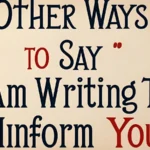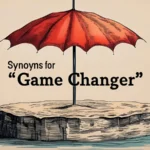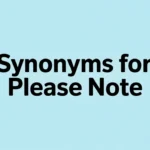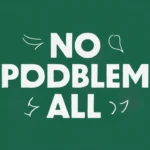Communication is a delicate art, and sometimes, we need to clarify our words to avoid misunderstandings. The phrase “Don’t get me wrong” is often used when we want to express something carefully without offending or confusing others. It helps soften statements that might seem harsh, critical, or unexpected. However, relying on the same phrase repeatedly can make conversations feel monotonous. Other Ways to Say “Don’t Get Me Wrong”.
Fortunately, there are many alternatives that convey the same meaning while adding variety and nuance to your speech. Whether you’re writing professionally, engaging in casual conversations, or making a point in debates, switching up your language can make a significant difference.
In this article, we’ll explore fifteen alternative ways to say “Don’t get me wrong” while maintaining clarity and impact. Each option comes with context and examples to help you integrate them seamlessly into your conversations. Let’s dive into these powerful expressions and enhance your communication skills!
I Don’t Mean to Offend, But…
This phrase works well when you need to express an opinion or concern without sounding too harsh. It acknowledges the possibility of offense while making it clear that no harm is intended. This can be particularly useful in sensitive discussions or when offering constructive criticism.
For example, if you’re giving feedback on a project, you might say: “I don’t mean to offend, but I think this section could use some improvement.” This keeps the conversation professional and open to discussion rather than defensive.
Using this phrase also allows the listener to prepare themselves emotionally for a potentially critical statement. It’s a great way to express honesty while showing empathy.
If you want to ensure clarity and maintain positive relationships, this phrase is an excellent alternative to “Don’t get me wrong.” It allows for open discussion while minimizing the risk of misinterpretation.
Read More: Other Ways to Say “Doesn’t Make Sense”
No Disrespect, But…
When you need to disagree or state an opinion that may be controversial, this phrase helps maintain respect. It signals that your intent is not to belittle or insult but simply to share a different perspective.
For example, in a debate about sports teams, you could say: “No disrespect, but I think the other team played better.” This softens the impact of disagreement and keeps the conversation from becoming confrontational.
People often react defensively when they feel their views are being challenged. By prefacing your statement with this phrase, you reduce tension and create a more open discussion. However, it’s essential to use this genuinely—if your statement is actually disrespectful, this phrase won’t magically make it polite.
Using “No disrespect, but…” is a simple yet effective way to introduce a different viewpoint while maintaining a positive and respectful tone.
I See Your Point, But…
This phrase acknowledges the other person’s perspective before presenting a different angle. It’s a great way to show that you are actively listening and value their opinion, even if you don’t fully agree.
For example, in a workplace discussion, you might say: “I see your point, but I think we should consider another approach.” This keeps the conversation collaborative rather than combative.
By using this phrase, you create a bridge between viewpoints rather than shutting down the other person’s argument. It encourages open dialogue and shows that you are willing to consider multiple perspectives.
This alternative is especially useful in professional or academic settings where respectful disagreement is essential. Instead of dismissing someone’s ideas outright, you acknowledge them while introducing your own thoughts in a constructive manner.
Don’t Take This the Wrong Way, But…
This phrase serves as a gentle warning that what follows might be misinterpreted. It signals that your intention is not to criticize harshly but to offer honest input.
For example, if a friend is making an unusual fashion choice, you might say: “Don’t take this the wrong way, but that color doesn’t really suit you.” This makes it clear that your comment isn’t meant to be rude, just an observation.
This phrase is particularly useful in personal conversations where emotions are involved. It helps prevent unnecessary hurt feelings while allowing you to speak candidly.
However, it’s important to pair this phrase with a neutral or kind tone. If your words sound too harsh, the listener may still take offense despite your attempt to soften the message.
I Mean No Harm, But…
This phrase reassures the listener that your words are coming from a place of honesty rather than malice. It’s particularly effective when discussing sensitive topics or giving advice.
For example, if you’re advising a coworker, you might say: “I mean no harm, but I think your approach could be more efficient.” This signals that your intent is to help, not to criticize unfairly.
In conversations where emotions run high, this phrase can be a lifesaver. It allows you to be direct without sounding aggressive or dismissive. People appreciate honesty, but they also appreciate kindness—this phrase helps balance both.
By incorporating “I mean no harm, but…” into your vocabulary, you can navigate difficult discussions with greater ease and ensure that your message is received with an open mind.
Don’t Misunderstand Me, But…
This phrase explicitly asks the listener to consider your statement in the right context. It’s useful when you’re about to say something that might be easily misinterpreted.
For example, if discussing work ethics, you might say: “Don’t misunderstand me, but I think we need to adjust our priorities.” This clarifies that your intent is constructive rather than negative.
Miscommunication is a common issue in both personal and professional settings. By using this phrase, you encourage others to listen carefully rather than jumping to conclusions.
This alternative helps create a more open-minded conversation where both sides feel heard and respected. It’s a valuable tool for maintaining clarity in discussions.
Just to Be Clear…
This phrase is straightforward and prevents misinterpretation by ensuring that your message is understood exactly as intended. It works well when you’re explaining something that could be taken the wrong way.
For example, in a discussion about deadlines, you might say: “Just to be clear, I’m not saying we should rush—I just think we need to manage our time better.” This ensures that your point isn’t misunderstood.
Using “Just to be clear…” signals that you are clarifying rather than contradicting. It makes communication smoother and reduces the risk of conflict.
This phrase is a powerful way to refine your message while keeping conversations productive and respectful.
That’s Not What I Meant…
This phrase is perfect when someone misinterprets your words, and you need to clarify your true meaning. It immediately signals that the listener might have misunderstood and that you want to correct any confusion.
For example, if a friend thinks you were being rude, you might say: “That’s not what I meant… I was just trying to say that I prefer a different option.” This helps prevent unnecessary conflict and keeps the conversation on track.
Using “That’s not what I meant…” also gives you a chance to rephrase your statement in a more precise way. This is particularly useful in professional settings where clear communication is essential.
In any conversation, misunderstandings are bound to happen. This phrase ensures that you can correct any misinterpretation without sounding defensive or argumentative, keeping the discussion productive and respectful.
Let Me Clarify…
When you feel that your message may have been unclear, this phrase helps you provide additional explanation. It’s useful in both casual and formal conversations, allowing you to refine your point without sounding abrupt.
For example, in a business meeting, you might say: “Let me clarify—I’m not saying we should abandon the project, just that we need to adjust our timeline.” This ensures that your words are interpreted correctly.
This phrase is particularly effective when you’re discussing complex topics or giving feedback. It signals that you are willing to explain further and that you value clarity in communication.
By using “Let me clarify…”, you keep conversations open and cooperative. It shows that you care about being understood and are making an effort to prevent miscommunication.
I’m Not Trying to Be Rude, But…
When you need to say something honest but potentially sensitive, this phrase helps soften the impact. It reassures the listener that you are not speaking with bad intentions.
For example, if giving fashion advice, you could say: “I’m not trying to be rude, but I think that jacket doesn’t match your outfit.” This makes it clear that your statement is meant to be helpful, not insulting.
However, it’s important to use this phrase sincerely. If your words are too harsh, the phrase alone won’t make them less offensive. Pairing it with a kind tone and constructive feedback ensures that your message is received well.
Using “I’m not trying to be rude, but…” allows you to express your opinion while maintaining politeness and respect in your conversation.
I Hope This Doesn’t Come Across the Wrong Way…
This phrase is great when you’re concerned that your words might be misinterpreted. It reassures the listener that you’re speaking with good intentions and want to avoid any offense.
For example, if discussing a sensitive topic, you might say: “I hope this doesn’t come across the wrong way, but I think we should reconsider our strategy.” This keeps the conversation constructive.
This phrase works well in situations where emotions are involved. It signals that you are aware of how your words might be received and that you’re making an effort to be diplomatic.
By using “I hope this doesn’t come across the wrong way…”, you create a respectful and open space for discussion, reducing the chances of conflict or misunderstanding.
I Just Want to Make Sure We’re on the Same Page…
When discussing important matters, ensuring mutual understanding is crucial. This phrase helps confirm that both parties share the same perspective before continuing the conversation.
For example, in a team meeting, you could say: “I just want to make sure we’re on the same page—are we agreeing that this is the best solution?” This promotes clarity and prevents future confusion.
This phrase is particularly useful in workplaces, academic settings, and negotiations. It emphasizes collaboration and ensures that everyone is aligned before moving forward.
Using “I just want to make sure we’re on the same page…” keeps discussions productive and ensures that misunderstandings are addressed before they become larger issues.
I Don’t Want You to Take This the Wrong Way…
This phrase works well when you’re about to share an opinion that could be easily misinterpreted. It signals that you are speaking with good intentions.
For example, when giving personal advice, you might say: “I don’t want you to take this the wrong way, but I think you might be overreacting.” This softens the message while still being honest.
This phrase is particularly useful in personal conversations where emotions are involved. It helps maintain a positive relationship while allowing you to express your thoughts freely.
By using “I don’t want you to take this the wrong way…”, you create a safe space for honest dialogue while minimizing the risk of conflict.
I Mean No Offense, But…
When discussing delicate topics, this phrase helps reassure the listener that you are not trying to insult or criticize unfairly. It allows you to share an honest opinion while showing respect.
For example, in a discussion about work habits, you might say: “I mean no offense, but I think we could improve our efficiency.” This keeps the conversation focused on solutions rather than criticism.
This phrase is best used when offering constructive feedback. It helps maintain professionalism and ensures that your words are interpreted in the right spirit.
By incorporating “I mean no offense, but…”, you encourage open communication while keeping conversations respectful and productive.
I Just Want to Be Honest With You…
Honesty is important in any conversation, and this phrase helps you introduce your thoughts in a direct yet considerate way. It reassures the listener that you are speaking truthfully without intending harm.
For example, when advising a friend, you might say: “I just want to be honest with you—I think this decision might not be the best for you.” This shows care and sincerity.
This phrase is particularly effective in personal relationships. It builds trust and encourages open, heartfelt conversations.
Using “I just want to be honest with you…” ensures that your message is clear while maintaining a tone of kindness and respect.
To Be Fair…
This phrase helps introduce a balanced perspective, making your point more objective and less confrontational. It signals that you are considering all sides of an issue.
For example, in a debate about work responsibilities, you might say: “To be fair, both teams have been working hard.” This acknowledges different viewpoints while keeping the discussion neutral.
This phrase is useful when discussing disagreements, as it prevents one-sided arguments and promotes fairness.
By using “To be fair…”, you demonstrate open-mindedness and encourage constructive dialogue.
I’m Just Saying…
This phrase helps emphasize that your statement is simply an observation or opinion, not a personal attack. It keeps the conversation casual and light.
For example, in a group discussion, you might say: “I’m just saying, maybe we should consider a different approach.” This makes your suggestion feel less forceful and more open-ended.
This phrase is great for informal conversations, allowing you to express thoughts without creating unnecessary tension.
By using “I’m just saying…”, you keep discussions friendly and encourage open exchange of ideas.
What I Meant to Say Was…
When you realize that your words may have been misunderstood, this phrase helps you rephrase and clarify your point.
For example, if someone reacts negatively, you might say: “What I meant to say was that I think there’s room for improvement, not that your work is bad.” This corrects the misunderstanding.
This phrase is particularly useful in high-stakes conversations where clarity is essential.
By using “What I meant to say was…”, you ensure that your true message is understood and avoid unnecessary conflicts.
I Just Want to Make Myself Clear…
This phrase helps emphasize your intent and ensures that your message is not misinterpreted.
For example, in a business setting, you could say: “I just want to make myself clear—I’m suggesting an adjustment, not a complete change.” This prevents confusion.
By using “I just want to make myself clear…”, you create stronger and more effective communication.
I’m Not Saying That…
This phrase is useful when you need to clarify that you are not making a particular claim but rather presenting a different perspective. It helps prevent misunderstandings before they escalate.
For example, in a discussion about team responsibilities, you might say: “I’m not saying that your work isn’t valuable, but I think we need to balance the workload differently.” This ensures that your point is understood without sounding dismissive.
This phrase works well in professional and personal conversations where someone might misinterpret your words. It keeps the discussion constructive and allows you to express your thoughts clearly.
By using “I’m not saying that…”, you maintain a respectful tone while ensuring that your message is delivered accurately. This helps prevent unnecessary conflict and keeps communication smooth and effective
Conclusion
Effective communication is all about clarity and respect. By using alternatives to “Don’t get me wrong,” you can express your thoughts with precision while maintaining positive relationships. These phrases allow you to soften your statements, clarify misunderstandings, and encourage open discussions. The key is to choose the right phrase for the situation, ensuring that your words are received in the best possible way.










